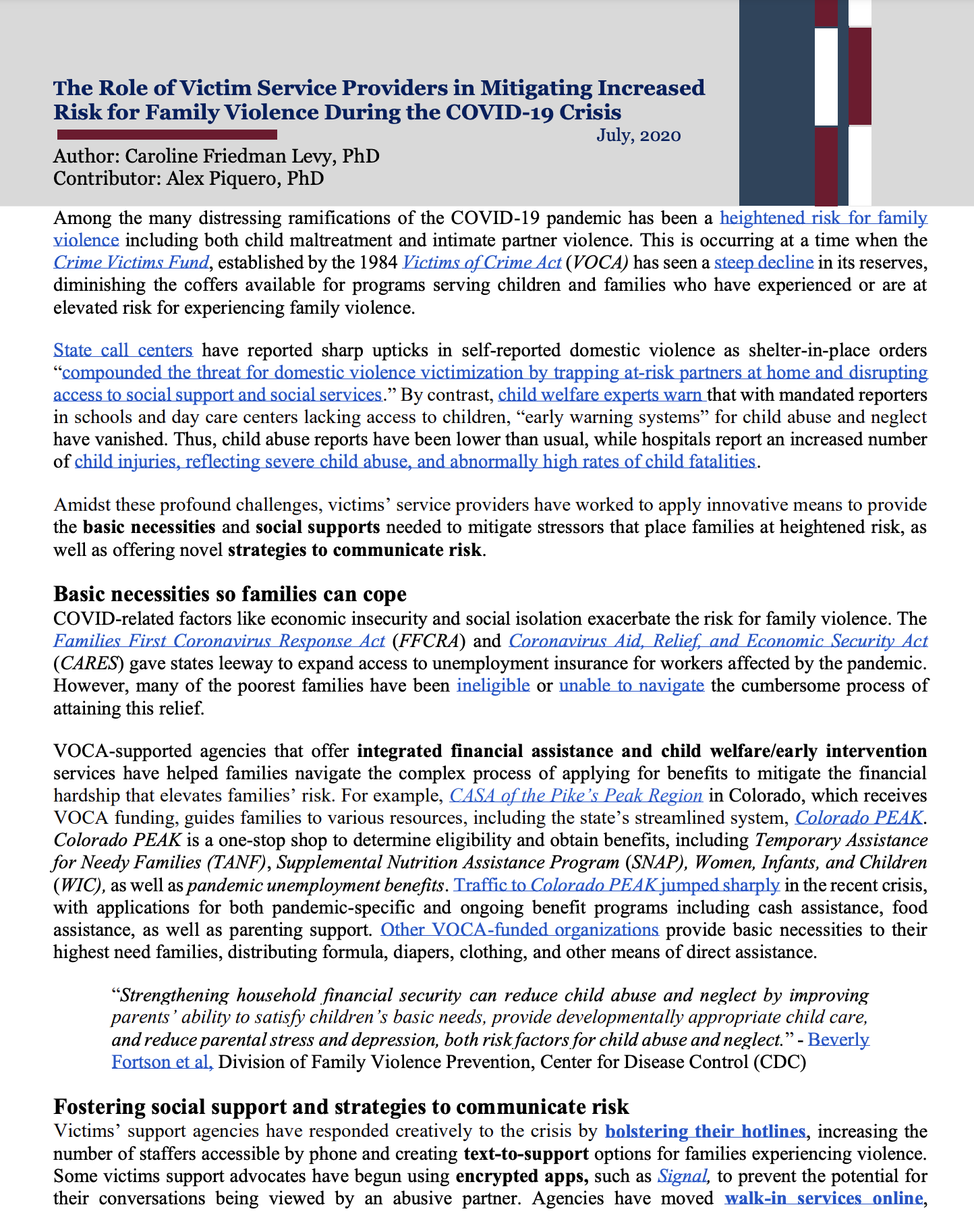
Among the many distressing ramifications of the COVID-19 pandemic has been a heightened risk for family violence including both child maltreatment and intimate partner violence. This is occurring at a time when the Crime Victims Fund, established by the 1984 Victims of Crime Act (VOCA) has seen a steep decline in its reserves, diminishing the coffers available for programs serving children and families who have experienced or are at elevated risk for experiencing family violence.
State call centers have reported sharp upticks in self-reported domestic violence as shelter-in-place orders “compounded the threat for domestic violence victimization by trapping at-risk partners at home and disrupting access to social support and social services.” By contrast, child welfare experts warn that with mandated reporters in schools and day care centers lacking access to children, “early warning systems” for child abuse and neglect have vanished. Thus, child abuse reports have been lower than usual, while hospitals report an increased number of child injuries, reflecting severe child abuse, and abnormally high rates of child fatalities.
Amidst these profound challenges, victims’ service providers have worked to apply innovative means to provide the basic needs and social supports needed to mitigate stressors that place families at heightened risk, as well as offering novel strategies to communicate risk.
Basic Necessities So Families Can Cope
COVID-related factors like economic insecurity and social isolation exacerbate the risk for family violence. The Families First Coronavirus Response Act (FFCRA) and Coronavirus Aid, Relief, and Economic Security Act (CARES) gave states leeway to expand access to unemployment insurance for workers affected by the pandemic. However, many of the poorest families have been ineligible or unable to navigate the cumbersome process of attaining this relief.
VOCA-supported agencies that offer integrated financial assistance and child welfare/early intervention services have helped families navigate the complex process of applying for benefits to mitigate the financial hardship that elevates families’ risk. For example, CASA of the Pike’s Peak Region in Colorado, which receives VOCA funding, guides families to various resources, including the state’s streamlined system, Colorado PEAK. Colorado PEAK is a one-stop shop to determine eligibility and obtain benefits, including Temporary Assistance for Needy Families (TANF), Supplemental Nutrition Assistance Program (SNAP), Women, Infants, and Children (WIC), as well as pandemic unemployment benefits. Traffic to Colorado PEAK jumped sharply in the recent crisis, with applications for both pandemic-specific and ongoing benefit programs including cash assistance, food assistance, as well as parenting support. Other VOCA-funded organizations provide basic necessities to their highest need families, distributing formula, diapers, clothing, and other means of direct assistance.
“Strengthening household financial security can reduce child abuse and neglect by improving parents’ ability to satisfy children’s basic needs, provide developmentally appropriate child care, and reduce parental stress and depression, both risk factors for child abuse and neglect.” – Beverly Fortson et al, Division of Family Violence Prevention, Center for Disease Control (CDC)
Fostering Social Support And Strategies to Communicate Risk
Victims’ support agencies have responded creatively to the crisis by bolstering their hotlines, increasing the number of staffers accessible by phone and creating text-to-support options for families experiencing violence. Some victims support advocates have begun using encrypted apps, such as Signal, to prevent the potential for their conversations being viewed by an abusive partner. Agencies have moved walk-in services online, connecting victims with pro bono attorneys who can walk clients remotely through the process of filing for orders of protection. A consortium serving families in San Francisco helped update emergency call systems in the city so that victims of family violence could text 911, often a safer option than phoning.
VOCA-funded agencies supporting children have also worked to ensure that teachers and social workers have increased the number of video visits they engage in with children who had previously been identified as being at elevated risk for abuse or neglect. Family case workers have been conducting virtual visits using FaceTime or Zoom, asking that children take their device into their bedroom to talk alone. While such visits are far from ideal in assessing risk, case managers have noted that virtual visits have been a helpful way of meeting with families with transportation issues.
As shelter-in-place rules recede across the country, risks posed by COVID-19, including the increased risk of family violence, have not. Agencies serving victims of family violence will need continued funding to help staff better assess risk, reduce stressors, and ensure that families have the basic necessities and social support they need to live safely.
End Notes / References
Boserup, B., McKenney, M., & Elkbuli, A. (2020). Alarming trends in US domestic violence during the COVID-19 pandemic. The American Journal of Emergency Medicine.
Bradbury‐Jones, C., & Isham, L. (2020). The pandemic paradox: The consequences of COVID‐19 on domestic violence. Journal of clinical nursing.
Campbell, A. M. (2020). An increasing risk of family violence during the Covid-19 pandemic: Strengthening community collaborations to save lives. Forensic Science International: Reports, 100089.
Cuartas, J. (2020). Heightened risk of child maltreatment amid the COVID-19 pandemic can exacerbate mental health problems for the next generation. Psychological trauma: theory, research, practice, and policy.
Fortson, B. L., Klevens, J., Merrick, M. T., Gilbert, L. K., & Alexander, S. P. (2016). Preventing child abuse and neglect: A technical package for policy, norm, and programmatic activities.
Piquero, A.R., Riddell, J.R., Bishopp, S.A. et al. (2020). Staying Home, Staying Safe? A Short-Term Analysis of COVID-19 on Dallas Domestic Violence. American Journal of Criminal Justice.
Usher, K., Bhullar, N., Durkin, J., Gyamfi, N., & Jackson, D. (2020). Family violence and COVID‐19: Increased vulnerability and reduced options for support. International journal of mental health nursing.
Whaling, K., Der Sarkissian, A., Larez, N. A., Sharkey, J. D., Allen, M. A., & Nylund-Gibson, K. (2020). Reduced child maltreatment prevention service case openings during COVID-19.
Wong, C. A., Ming, D., Maslow, G., & Gifford, E. J. (2020). Mitigating the impacts of the COVID-19 pandemic response on at-risk children. Pediatrics, 145(4), e20200973.
The Research-to-Policy Collaboration (RPC) works to bring together research professionals and public officials to support evidence-based policy. Please visit their website to learn more.
Key Information
RPC Website
Research-to-Policy Collaboration
More RPC Resources
RPC Resources
Publication DateJuly 1, 2020
Topic Area(s)Social Services, Health, Violence and Victimization
Resource TypeWritten Briefs
Share This Page
Among the many distressing ramifications of the COVID-19 pandemic has been a heightened risk for family violence including both child maltreatment and intimate partner violence. This is occurring at a time when the Crime Victims Fund, established by the 1984 Victims of Crime Act (VOCA) has seen a steep decline in its reserves, diminishing the coffers available for programs serving children and families who have experienced or are at elevated risk for experiencing family violence.
State call centers have reported sharp upticks in self-reported domestic violence as shelter-in-place orders “compounded the threat for domestic violence victimization by trapping at-risk partners at home and disrupting access to social support and social services.” By contrast, child welfare experts warn that with mandated reporters in schools and day care centers lacking access to children, “early warning systems” for child abuse and neglect have vanished. Thus, child abuse reports have been lower than usual, while hospitals report an increased number of child injuries, reflecting severe child abuse, and abnormally high rates of child fatalities.
Amidst these profound challenges, victims’ service providers have worked to apply innovative means to provide the basic needs and social supports needed to mitigate stressors that place families at heightened risk, as well as offering novel strategies to communicate risk.
Basic Necessities So Families Can Cope
COVID-related factors like economic insecurity and social isolation exacerbate the risk for family violence. The Families First Coronavirus Response Act (FFCRA) and Coronavirus Aid, Relief, and Economic Security Act (CARES) gave states leeway to expand access to unemployment insurance for workers affected by the pandemic. However, many of the poorest families have been ineligible or unable to navigate the cumbersome process of attaining this relief.
VOCA-supported agencies that offer integrated financial assistance and child welfare/early intervention services have helped families navigate the complex process of applying for benefits to mitigate the financial hardship that elevates families’ risk. For example, CASA of the Pike’s Peak Region in Colorado, which receives VOCA funding, guides families to various resources, including the state’s streamlined system, Colorado PEAK. Colorado PEAK is a one-stop shop to determine eligibility and obtain benefits, including Temporary Assistance for Needy Families (TANF), Supplemental Nutrition Assistance Program (SNAP), Women, Infants, and Children (WIC), as well as pandemic unemployment benefits. Traffic to Colorado PEAK jumped sharply in the recent crisis, with applications for both pandemic-specific and ongoing benefit programs including cash assistance, food assistance, as well as parenting support. Other VOCA-funded organizations provide basic necessities to their highest need families, distributing formula, diapers, clothing, and other means of direct assistance.
“Strengthening household financial security can reduce child abuse and neglect by improving parents’ ability to satisfy children’s basic needs, provide developmentally appropriate child care, and reduce parental stress and depression, both risk factors for child abuse and neglect.” – Beverly Fortson et al, Division of Family Violence Prevention, Center for Disease Control (CDC)
Fostering Social Support And Strategies to Communicate Risk
Victims’ support agencies have responded creatively to the crisis by bolstering their hotlines, increasing the number of staffers accessible by phone and creating text-to-support options for families experiencing violence. Some victims support advocates have begun using encrypted apps, such as Signal, to prevent the potential for their conversations being viewed by an abusive partner. Agencies have moved walk-in services online, connecting victims with pro bono attorneys who can walk clients remotely through the process of filing for orders of protection. A consortium serving families in San Francisco helped update emergency call systems in the city so that victims of family violence could text 911, often a safer option than phoning.
VOCA-funded agencies supporting children have also worked to ensure that teachers and social workers have increased the number of video visits they engage in with children who had previously been identified as being at elevated risk for abuse or neglect. Family case workers have been conducting virtual visits using FaceTime or Zoom, asking that children take their device into their bedroom to talk alone. While such visits are far from ideal in assessing risk, case managers have noted that virtual visits have been a helpful way of meeting with families with transportation issues.
As shelter-in-place rules recede across the country, risks posed by COVID-19, including the increased risk of family violence, have not. Agencies serving victims of family violence will need continued funding to help staff better assess risk, reduce stressors, and ensure that families have the basic necessities and social support they need to live safely.
End Notes / References
Boserup, B., McKenney, M., & Elkbuli, A. (2020). Alarming trends in US domestic violence during the COVID-19 pandemic. The American Journal of Emergency Medicine.
Bradbury‐Jones, C., & Isham, L. (2020). The pandemic paradox: The consequences of COVID‐19 on domestic violence. Journal of clinical nursing.
Campbell, A. M. (2020). An increasing risk of family violence during the Covid-19 pandemic: Strengthening community collaborations to save lives. Forensic Science International: Reports, 100089.
Cuartas, J. (2020). Heightened risk of child maltreatment amid the COVID-19 pandemic can exacerbate mental health problems for the next generation. Psychological trauma: theory, research, practice, and policy.
Fortson, B. L., Klevens, J., Merrick, M. T., Gilbert, L. K., & Alexander, S. P. (2016). Preventing child abuse and neglect: A technical package for policy, norm, and programmatic activities.
Piquero, A.R., Riddell, J.R., Bishopp, S.A. et al. (2020). Staying Home, Staying Safe? A Short-Term Analysis of COVID-19 on Dallas Domestic Violence. American Journal of Criminal Justice.
Usher, K., Bhullar, N., Durkin, J., Gyamfi, N., & Jackson, D. (2020). Family violence and COVID‐19: Increased vulnerability and reduced options for support. International journal of mental health nursing.
Whaling, K., Der Sarkissian, A., Larez, N. A., Sharkey, J. D., Allen, M. A., & Nylund-Gibson, K. (2020). Reduced child maltreatment prevention service case openings during COVID-19.
Wong, C. A., Ming, D., Maslow, G., & Gifford, E. J. (2020). Mitigating the impacts of the COVID-19 pandemic response on at-risk children. Pediatrics, 145(4), e20200973.
The Research-to-Policy Collaboration (RPC) works to bring together research professionals and public officials to support evidence-based policy. Please visit their website to learn more.

Key Information
RPC Website
Research-to-Policy Collaboration
More RPC Resources
RPC Resources
Publication DateJuly 1, 2020
Topic Area(s)Social Services, Health, Violence and Victimization
Resource TypeWritten Briefs
Share This Page
LET’S STAY IN TOUCH
Join the Evidence-to-Impact Mailing List
Keep up to date with the latest resources, events, and news from the EIC.




